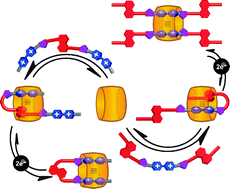Abstract
Two donor–acceptor thread-like compounds incorporating viologen (V2+) units and 1,5-dihydroxynaphthalene (DNP) stations have been prepared. Their ability to form self-assembled charge-transfer (CT) complexes with

- This article is part of the themed collection: In honour of Jean-Pierre Sauvage

 Please wait while we load your content...
Please wait while we load your content...